If you’re wondering how to grow kohlrabi successfully, the process is simpler than you might think. By focusing on the right planting times, soil preparation, and proper care, you can enjoy a bountiful harvest of this cool-season vegetable. Whether you’re planting in spring or preparing for a fall harvest, mastering how to grow kohlrabi involves understanding the nuances of spacing, watering, and pest control, ensuring your crop thrives in both cooler and warmer climates.
Mastering the Art of Growing Kohlrabi
Perfect Timing: When to Plant Kohlrabi
Timing is everything when it comes to growing kohlrabi. Wondering when to plant those seeds? Aim for 1-2 weeks before the last frost in the spring. If you prefer using transplants, they can also go into the ground about 1-2 weeks before the last frost date. Planning a fall harvest? Choose early-maturing varieties and plant them roughly 50 days before you expect them to be ready. This way, your kohlrabi will mature just in time to avoid the hottest weather.
Soil Preparation: Setting the Stage for Success
Kohlrabi thrives in soil that’s rich, well-drained, and full of organic matter. Before planting, take the time to enrich your soil with compost and a balanced fertilizer. If you’re serious about getting the best results, consider performing a soil test to determine the exact nutrients your soil may need. Work these into the top 6 inches of soil to create the perfect environment for your kohlrabi.
Planting Techniques: Depth and Spacing Matter
Getting the planting depth and spacing right is crucial for healthy growth. Plant your seeds about ¼-½ inch deep in the soil. Once your seedlings emerge, thin them or transplant them to ensure they’re spaced 6 inches apart, with rows about 1 foot apart. This spacing gives each plant enough room to grow without competing for nutrients.
Temperature Tips: Navigating the Climate
Kohlrabi is a bit finicky when it comes to temperature. It’s the least hardy of the cabbage family, preferring cooler climates where temperatures stay below 75°F. If the mercury dips below 45°F, your plants might start to flower prematurely, while hot weather can cause the stems to become woody and tough. To keep your kohlrabi happy, aim for that sweet spot between cool and warm.
Watering Wisdom: Keeping Consistent Moisture Levels
Kohlrabi needs a consistent supply of water to thrive. Aim to give your plants about 1-2 inches of water per week. Be careful, though—fluctuations in moisture can lead to tough, woody stems. Regular, even watering is key to keeping your kohlrabi tender and delicious.
Feeding Your Plants: Fertilization Facts
Three weeks after transplanting or thinning, give your kohlrabi a boost by applying a nitrogen-rich fertilizer (21-0-0). Use about ½ cup per 10 feet of row, placing it about 6 inches from the plants, and water it in well. This encourages rapid growth and helps your plants reach their full potential.
Mulching and Protecting: Using Mulches and Row Covers
Mulches are your best friend when growing kohlrabi. Plastic mulches are great for conserving water, reducing weeds, and allowing for earlier planting. As temperatures rise, switch to organic mulches like grass clippings, straw, or shredded newspaper. These will help cool the soil, retain moisture, and keep weeds at bay. If frost or pests are a concern, consider using fabric row covers to protect your young plants.
Pest Patrol: Common Pests and How to Handle Them
Even in a well-tended garden, pests can pose a problem. Be on the lookout for:
- Aphids: These tiny green or black insects can be controlled with insecticidal soap or a strong spray of water.
- Cabbage Worms and Loopers: These green worms love to chew on kohlrabi leaves. Control them with appropriate insecticides or by introducing natural predators.
- Flea Beetles: These small, black beetles can be particularly damaging to seedlings. Apply insecticides at the first sign of trouble to keep them in check.
Reaping the Rewards: Harvesting Kohlrabi
When your kohlrabi’s swollen stem reaches 2-3 inches in diameter, it’s time to harvest. Don’t wait too long—larger stems tend to become tough and woody. After harvesting, kohlrabi can be stored for 2-3 weeks at 32°F with 95% relative humidity, allowing you to enjoy your homegrown veggies well into the season.
Variety Choices: Selecting the Best Kohlrabi
Not all kohlrabi varieties are created equal. For a successful crop, consider planting varieties like Quickstar, Grand Duke, White Vienna, or Purple Vienna. These have been proven to deliver excellent yields and flavor.
Maximizing Productivity: How Much to Plant
To ensure a steady supply, plan on planting 3-5 feet of row per person for fresh use. If you’re thinking about storing or processing, increase this to 5-10 feet of row. You can expect to harvest about 5-7 pounds of kohlrabi per 10 feet of row, making it a productive addition to any garden.
Nutritional Benefits: What’s in Kohlrabi for You
Beyond being tasty, kohlrabi is a nutritional powerhouse. It’s fat-free and packed with fiber and potassium, making it a healthy choice for any diet.
FAQs
What should not be planted next to kohlrabi?
Kohlrabi doesn’t do well when planted next to other members of the brassica family, like broccoli, cauliflower, and cabbage, as they can compete for the same nutrients and attract similar pests. Additionally, avoid planting kohlrabi near pole beans or tomatoes, as these can hinder its growth.
How much space does kohlrabi need?
Kohlrabi requires ample space to grow properly. Ideally, plant kohlrabi seeds or transplants 6 inches apart within the row, with rows spaced 12 inches apart. This spacing ensures that each plant has enough room to develop without competing for resources.
Can kohlrabi be grown in containers?
Yes, kohlrabi can be grown in containers, making it a great option for gardeners with limited space. Choose a container that is at least 12 inches deep and wide, and plant one or two kohlrabi plants per container. Ensure the container has good drainage and use a high-quality potting mix rich in organic matter.
How long does kohlrabi take to grow?
Kohlrabi typically takes between 50 to 60 days to reach maturity, depending on the variety and growing conditions. For example, early-maturing varieties like Quickstar can be ready in as little as 40 days, while others may take closer to 60 days. Keep an eye on the size of the stem, harvesting when it reaches 2-3 inches in diameter for the best flavor and texture.


